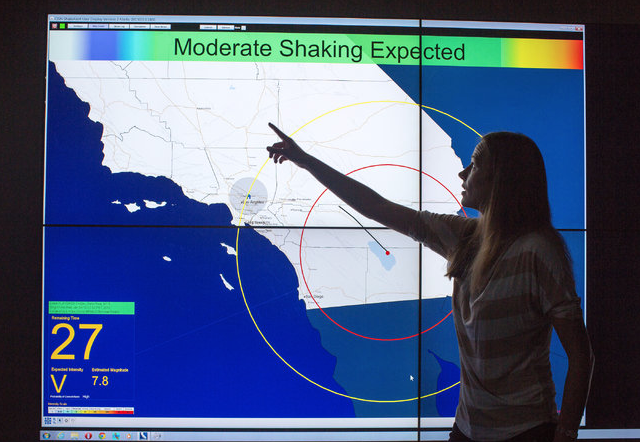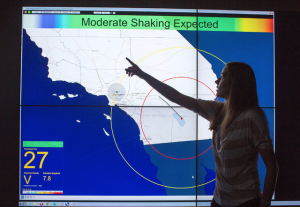Earthquake early warning system could give alert 60-seconds in advance

Earthquake early warning system could give alert 60-seconds in advance
The New York Times reports: Progress Stalls in California on Earthquake Warnings
By ADAM NAGOURNEY
PASADENA, Calif. — Scientists at the Caltech Seismology Laboratory were at their computers last week when a warning popped up on the screen: “Earthquake, earthquake!” The initial magnitude of the quake, 100 miles away, was 5.2, the alert said, and a countdown clock warned that mild shaking would reach here in 40 seconds.

Maren Boese, a research fellow at Caltech, demonstrating an earthquake simulation along the San Andreas Fault (photo: NY Times)
“Since I did not expect any damage, I did not dive under the desk,” said Kate Hutton, a staff seismologist. Instead, she sat and waited to feel the rumble beneath her laboratory at the California Institute of Technology, which arrived precisely as predicted.
Ms. Hutton was enjoying, as it were, the benefits of an ambitious if unfinished earthquake alert system for California, intended to one day give as much as 60 seconds’ warning of an approaching quake — to hospitals, emergency response workers and anyone near a cellphone or computer — in an attempt to reduce the casualties and the damage that officials have long feared were as inevitable as another huge California earthquake.
But the episode, set off by what proved to be a harmless earthquake in the desert on March 11, instead provided a disquieting reminder of how far California lags behind other earthquake-prone places — notably Japan and Mexico — in completing an effective alert system that is clearly within technological and financial reach. Even as others surge ahead, the network in California — which would be the first in the nation — is a work in progress, a beta system with patchwork software sending alerts to just 100 geologists and selected emergency workers.
Last month, state lawmakers introduced legislation calling for an expedited program to raise the $80 million needed to complete the program, but acknowledged they did not know where the money might come from.
A fully operational system would use a network of sensors — 300 are in place now, but hundreds more are needed — to detect the first signs of a rupture, using the data to project the severity and breadth of the quake, the area most likely to be damaged and the number of seconds until the shaking begins. As demonstrated in Japan, even a 30-second notice was enough to activate computerized programs to slow commuter trains so they did not go off their tracks, stop elevators so passengers were not stranded between floors, flash highway warning signs instructing motorists to slow down and avoid overpasses, and open doors at fire stations so they would not be stuck shut should power be lost.
Read the full story at The New York Times
Comments
Scott Brennan is the publisher of this newspaper and founder of Access Publishing. Follow him on Twitter, LinkedIn, or follow his blog.




















